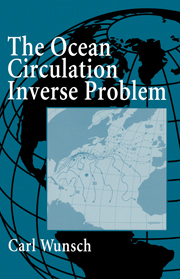5 - Additional Useful Methods
Published online by Cambridge University Press: 07 May 2010
Summary
This chapter describes a potpourri of ideas, techniques, and applications not covered in Chapter 3. A number of issues raised in Chapter 4-for example, how to impose inequality constraints-are discussed. We take up the problem of understanding the errors in the coefficient matrices E, which have not hitherto been much addressed. Further application of the SVD to a variety of problems, including how to best make maps of the ocean properties, is described. Few of the results are in any sense complete (many books exist devoted to linear programming alone, for example), but they are intended to indicate some of the ideas and methods that can be employed for quantitative description of the ocean circulation, which remain for future work.
The problems discussed in the last chapter raise a number of issues about the models that are difficult to address with the mathematical machinery already available. Among those which seem most important to deal with are the nonlinearities, which are in turn of at least two types, and the grossly underdetermined nature of the conventional large-scale box inversions.
Inequality Constraints; Nonnegative Least Squares
There are a number of aspects of the estimation problem of the general circulation that suggest the usefulness of being able to impose inequality constraints upon the solutions. Problems involving tracer concentrations usually demand that they remain positive; eddy coefficients are sometimes regarded as acceptable only when positive; in some problems we may wish to impose directions, but not magnitudes, upon the flow fields.
Some of the figures in Chapter 2 (e.g., Figure 2–2) show huge tongues of properties extending for thousands of kilometers throughout the ocean.
- Type
- Chapter
- Information
- The Ocean Circulation Inverse Problem , pp. 297 - 323Publisher: Cambridge University PressPrint publication year: 1996



